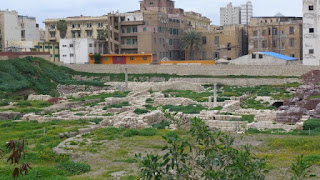Alexandria
Alexandria, Egypt
9 Feb 2016
Today we would be making a day trip to Alexandria, located by the Mediterranean Sea, about 250km away from Cairo by taking the train from Cairo Ramses railway station. To get to the train station, we walked from our hotel to Naguib Metro station, then took the Metro to Al Shohada station. The Metro only cost EGP 1 Sadat Metro station is nearer to our hotel, but unfortunately, this station has been closed since the uprising in Egypt, probably due to its vicinity to Tahrir Square where the riots took place. The Metro coach is segregated by gender, so we were separated for the short ride to the railway station.
Our train was scheduled to depart at 9am and would take 2 hours 45 mins and the ticket cost EGP 45 per person per way. There was much confusion in buying the the train ticket. There was no signage on which counter to buy the ticket, so we had to ask around. The first counter we went to pushed us to the next counter as she did not speak English. The next counter asked us to go to another connecting building next to the station as we wanted to buy the Special (Express) train second class ticket. Apparently, the first counter we went to were only for first class tickets.
The train ride to Alexandria was smooth, passing through the green countryside to the Mediterranean coast. The train was comfortable and air conditioned. Refreshments are available on sale if one feels hungry or thirsty.
From the Misr Railway Station, we walked to the Kom El-Dikaa Roman Amphitheatre, the only such structure in Egypt. The entrance fee is EGP 30 per person and EGP 20 for our tripod. The amphitheatre was used as an odeum for musical shows during the Roman period; as a conference hall in the Byzantine era and various other events up till the 7th century.
To the North of the Roman theatre, there are large mud brick structures which are ruins of the Roman baths that were constructed in the period from the 2nd to the 4th century AD.
Below the amphitheatre is a small Roman home which date from the reign of Roman Emperor Hadrian. This house is called the Villa of the Birds with beautiful mosaic displays of various birds. We saw the signage to this villa, but we couldn't find the entrance, so we somehow missed this villa.
There is also an outdoor exhibition of Pharaonic and Greco-Roman era objects that have been excavated from the Mediterranean Sea at the nearby Qaitbay Fort.
Facts excerpted from here and here
We then walked back towards the Misr Railway Station to take a taxi to the Qaitbay fort which is just about 10 minutes away. We agreed to pay 20 EGP for the fare. The cool breeze of the Mediterranean Sea was a welcome relief from hustle and bustle of the city. We walked straight to the Fort and paid the entrance fee of 10 EGP per person, thinking it was quite cheap; only to realize that we were actually entering the Maritime museum! Nothing much to see there, we quickly made our way out and walked a bit further to the correct entrance of the Qaitbay Fort. The entrance ticket is 30 EGP per person. We left our tripod at the ticket counter for collection later as the fort was quite packed so we wouldn't have much space to set up the tripod anyway.
Qaitbay Fort is a 15th-century defensive fortress, established in 1477 AD (882 AH) by Sultan Al-Ashraf Sayf al-Din Qa'it Bay. The Citadel is situated on the eastern side of the northern tip of Pharos Island.
Fact excerpted from here
From the fort, we walked along the beach road to the El Morsi Abou El Abbas mosque for prayers, before continuing to walk to the train station to catch our train back to Cairo at 6pm. We initially planned to go to the Bibliotheca Alexandrina, but had to cancel as it was already getting late. It was another challenge to buy the tickets back to Cairo, most at the counter did not speak English and kept passing us around until finally the last one standing understood what we wanted. To our disbelief, our tickets were handwritten in Arabic, luckily we could read the numbers. We had to ask a few other passengers in our train to double confirm that we were in the right train. We safely made our way back to Cairo, again taking the Metro back to Naguib station, then bought some takeaway food from Kazaz before reaching back at our hotel around 9pm.
9 Feb 2016
Today we would be making a day trip to Alexandria, located by the Mediterranean Sea, about 250km away from Cairo by taking the train from Cairo Ramses railway station. To get to the train station, we walked from our hotel to Naguib Metro station, then took the Metro to Al Shohada station. The Metro only cost EGP 1 Sadat Metro station is nearer to our hotel, but unfortunately, this station has been closed since the uprising in Egypt, probably due to its vicinity to Tahrir Square where the riots took place. The Metro coach is segregated by gender, so we were separated for the short ride to the railway station.
 |
| Metro ticket |
 |
| Metro Naguib station |
 |
| incoming MRT |
 |
| Cairo Ramses train station |
Our train was scheduled to depart at 9am and would take 2 hours 45 mins and the ticket cost EGP 45 per person per way. There was much confusion in buying the the train ticket. There was no signage on which counter to buy the ticket, so we had to ask around. The first counter we went to pushed us to the next counter as she did not speak English. The next counter asked us to go to another connecting building next to the station as we wanted to buy the Special (Express) train second class ticket. Apparently, the first counter we went to were only for first class tickets.
 |
| inside the Express train |
 |
| printed Cairo - Alexandria ticket |
The train ride to Alexandria was smooth, passing through the green countryside to the Mediterranean coast. The train was comfortable and air conditioned. Refreshments are available on sale if one feels hungry or thirsty.
 |
| some green pastures along the way |
 |
| crossing a river |
From the Misr Railway Station, we walked to the Kom El-Dikaa Roman Amphitheatre, the only such structure in Egypt. The entrance fee is EGP 30 per person and EGP 20 for our tripod. The amphitheatre was used as an odeum for musical shows during the Roman period; as a conference hall in the Byzantine era and various other events up till the 7th century.
 |
| We are here in Alex! |
 |
| Alexandria Misr Railway station facade |
 |
| Roman Ampitheather surrounded by modern buildings |
 |
| the Roman Ampitheathre |
To the North of the Roman theatre, there are large mud brick structures which are ruins of the Roman baths that were constructed in the period from the 2nd to the 4th century AD.
 |
| mud brick structures |
 |
| pillars and mud bricks |
 |
| the Roman ruins within city vicinity |
 |
| Roman baths |
Below the amphitheatre is a small Roman home which date from the reign of Roman Emperor Hadrian. This house is called the Villa of the Birds with beautiful mosaic displays of various birds. We saw the signage to this villa, but we couldn't find the entrance, so we somehow missed this villa.
There is also an outdoor exhibition of Pharaonic and Greco-Roman era objects that have been excavated from the Mediterranean Sea at the nearby Qaitbay Fort.
Facts excerpted from here and here
 |
| exhibits from the sea |
We then walked back towards the Misr Railway Station to take a taxi to the Qaitbay fort which is just about 10 minutes away. We agreed to pay 20 EGP for the fare. The cool breeze of the Mediterranean Sea was a welcome relief from hustle and bustle of the city. We walked straight to the Fort and paid the entrance fee of 10 EGP per person, thinking it was quite cheap; only to realize that we were actually entering the Maritime museum! Nothing much to see there, we quickly made our way out and walked a bit further to the correct entrance of the Qaitbay Fort. The entrance ticket is 30 EGP per person. We left our tripod at the ticket counter for collection later as the fort was quite packed so we wouldn't have much space to set up the tripod anyway.
 |
| boats by the Mediterranean Sea |
 |
| Mediterranean Sea |
 |
| souvenirs on sale. Fort Qaitbay in the background |
Qaitbay Fort is a 15th-century defensive fortress, established in 1477 AD (882 AH) by Sultan Al-Ashraf Sayf al-Din Qa'it Bay. The Citadel is situated on the eastern side of the northern tip of Pharos Island.
 |
| Qaitbay Fort |
 |
| Mediterranean Sea view from the fort |
 |
| View from the Qaitbay Fort |
Fact excerpted from here
 |
| boats by the beach |
 |
| road along the beach |
From the fort, we walked along the beach road to the El Morsi Abou El Abbas mosque for prayers, before continuing to walk to the train station to catch our train back to Cairo at 6pm. We initially planned to go to the Bibliotheca Alexandrina, but had to cancel as it was already getting late. It was another challenge to buy the tickets back to Cairo, most at the counter did not speak English and kept passing us around until finally the last one standing understood what we wanted. To our disbelief, our tickets were handwritten in Arabic, luckily we could read the numbers. We had to ask a few other passengers in our train to double confirm that we were in the right train. We safely made our way back to Cairo, again taking the Metro back to Naguib station, then bought some takeaway food from Kazaz before reaching back at our hotel around 9pm.
 |
| El Morsi Abou El Abbas mosque |
 |
| cheap freshly baked pretzels at 1 EGP for 5 pieces |
 |
| pretzel |
 |
| our handwritten ticket |
 |
| inside the train back to Cairo |
Labels: Travelogue





















